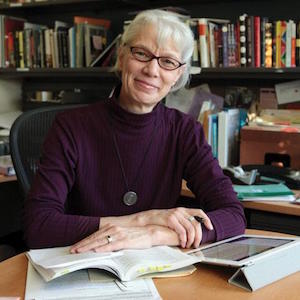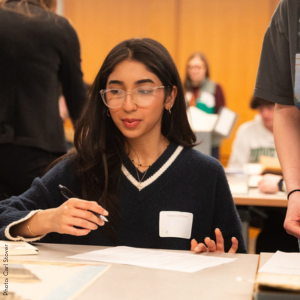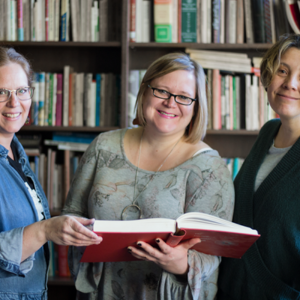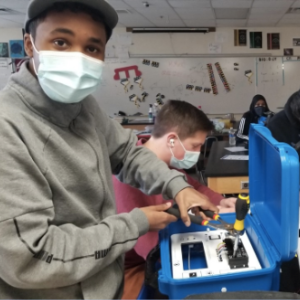For a quarter of a century, College in the Schools (CIS) has given Minnesota high school students a jump-start on college by making it possible for qualified students to earn University credits without leaving their local high schools.
Through CIS, students take University courses taught by their own teachers in their own classrooms. They receive both high school and U of M credit, while getting a feel for what will be expected of them in college. At the same time their teachers work with University faculty from sponsoring departments, learning what the U expects students to know and be able to do.
CIS has historically focused on high-achieving students, those in the top 20 percent of their class, who are the most confident and likely to have the skills and behaviors needed for college success. But in 2009, in response to a challenge from its advisory board, CIS launched the Entry Point Project to deliver the "CIS advantage" to a broader academic and demographic range of students.
Entry Point offers three credit-bearing courses: Writing Studio, Mathematical Modeling and Prediction, and Physics by Inquiry, geared to students in the "academic middle"—those between the 50th and 80th percentile of their class. All three incorporate Universal Instructional Design. This highly interactive pedagogy draws on what students already know or care about, emphasizes critical thinking and reflection on learning, and incorporates regular cycles of practice and feedback.
Barbara Hodne (shown to right), senior teaching specialist in the Department of Postsecondary Teaching and Learning, is the CIS faculty coordinator for Writing Studio. She organizes professional development for CIS teachers and ensures that U classes taught in the high schools retain University rigor.
In fact, her dedication to teachers and students recently was recognized when she was awarded the College of Continuing Education's Distinguished Educator of the Year award.
"It's a hands-on collaboration," she says. "Teachers are doing very creative work, and I've taken many of their ideas into my own classroom."
For example, during one classroom visit, Hodne observed a teacher demonstrating how to analyze each assignment and break it down into "jobs." "This is a very effective way to teach students how to interpret and understand what is expected in a college writing assignment," she says.
Sharon Ornelas (shown to right), who teaches bilingual students at Edison High School in Minneapolis, enjoys working with Hodne and the other Writing Studio CIS teachers. "We learn from each other. It's a very rich experience for me, and it also enriches my class," she says.
In Writing Studio, her students practice the kinds of writing they'll need to do in college. One assignment, for example, requires them to read an article, understand what the author is saying, and respond from their own perspective. Another assignment requires them to do primary research, such as interviews, surveys, and data collection.
Ornelas credits Writing Studio with changing the way she teaches. "I've learned to respond to student writing based on their individual needs. And I can share my understanding of college expectations with my colleagues," she says.
Her students aspire to attend college, but need more practice using college skills. Writing Studio meets that need. In fact, Ornelas says, "The entire Entry Point Project is cutting-edge. It's unique in the US. There's nothing quite like it anywhere else."
During its first year, the Entry Point Project served 262 students, most in the academic middle. Of these, 60 percent were students of color, 56 percent came from homes where English was not the primary language, 62 percent qualified for free or reduced lunch, and 48 percent came from families in which neither parent had attended college. Most importantly, Entry Point students were academically successful—91 percent earned university grades of C or better.
In 2011−12, 24 schools are participating in Entry Point, up from 13 that participated the first year. "We believe that Entry Point will continue to grow because it meets a critical need," says Susan Henderson, CIS director.
25 years of CIS
In the early 1980s, CCE program director Bill VanEssendelft became intrigued by Syracuse University's Project Advance, which allowed high school students to take university courses in their own schools. When the Post-Secondary Enrollment Options Act was signed into law in 1985, this kind of dual enrollment program became possible in Minnesota.
The following year, English professor Charlie Sugnet taught a course with Karen West, an English teacher at Johnson High School in Saint Paul. The course was successful, but sending University faculty into high schools several times a week wasn't feasible as a long-term strategy.
About the same time, another English professor, Lillian Bridwell-Bowles, recruited 10 high school teachers to offer Freshman Writing Practice Honors to their students. This pilot showed that high school teachers—with extensive preparation and regular contact with University faculty—could successfully teach college courses to high school students. This model became College in the Schools.
Today CIS offers 36 courses from 17 university academic departments. In 2010−11 over 6,100 students earned more than 38,600 U of M credits in courses offered by 296 teachers in 107 high schools.








